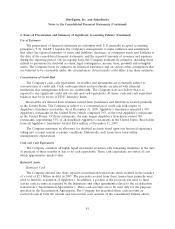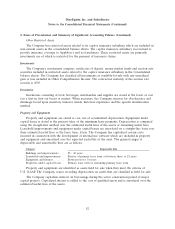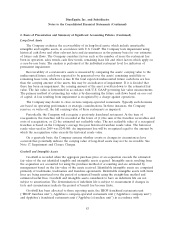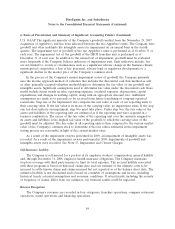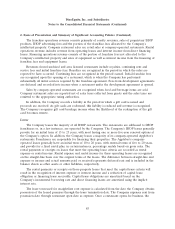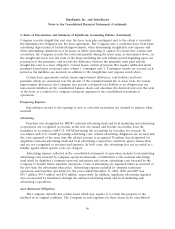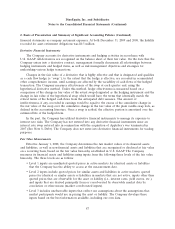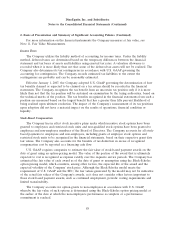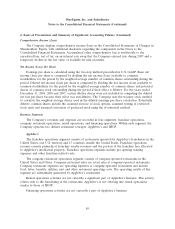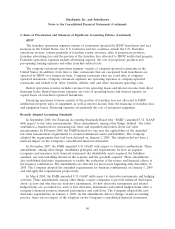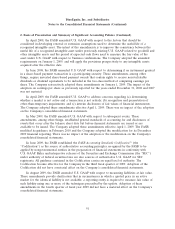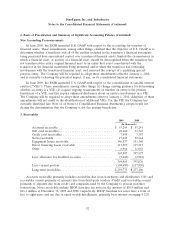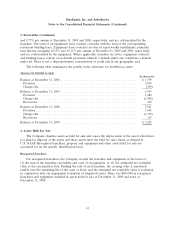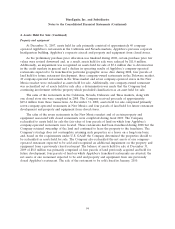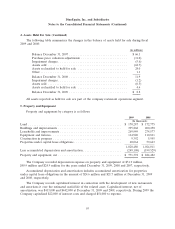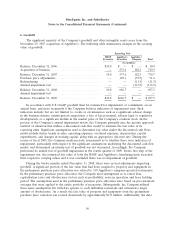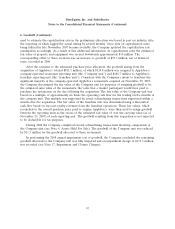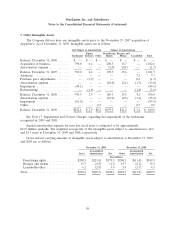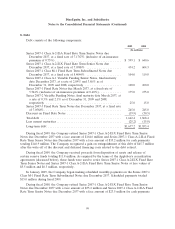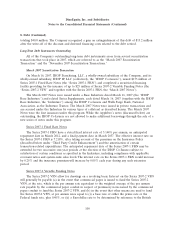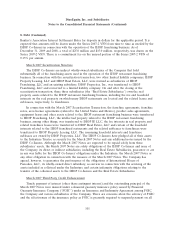IHOP 2009 Annual Report Download - page 110
Download and view the complete annual report
Please find page 110 of the 2009 IHOP annual report below. You can navigate through the pages in the report by either clicking on the pages listed below, or by using the keyword search tool below to find specific information within the annual report.DineEquity, Inc. and Subsidiaries
Notes to the Consolidated Financial Statements (Continued)
2. Basis of Presentation and Summary of Significant Accounting Policies (Continued)
In April 2008, the FASB amended U.S. GAAP with respect to the factors that should be
considered in developing renewal or extension assumptions used to determine the useful life of a
recognized intangible asset. The intent of the amendments is to improve the consistency between the
useful life of a recognized intangible asset under previously existing U.S. GAAP related to goodwill and
other intangible assets and the period of expected cash flows used to measure the fair value of the
asset under U.S. GAAP with respect to business combinations. The Company adopted the amended
requirements on January 1, 2009, and will apply the provisions prospectively to any intangible assets
acquired after the effective date.
In June 2008, the FASB amended U.S. GAAP with respect to determining if an instrument granted
in a share-based payment transaction is a participating security. These amendments, among other
things, require unvested share-based payment awards that contain rights to receive non-forfeitable
dividends or dividend equivalents to be included in the two-class method of computing earnings per
share. The Company retroactively adopted these amendments on January 1, 2009. The impact of the
adoption on earnings per share as previously reported for the years ended December 31, 2008 and 2007
was not material.
In April 2009, the FASB amended U.S. GAAP to address concerns regarding (a) determining
whether a market is not active and a transaction is not orderly; (b) recognition and presentation of
other-than-temporary impairments; and (c) interim disclosures of fair values of financial instruments.
The Company adopted these amendments effective April 1, 2009. There was no impact of the adoption
on the Company’s consolidated financial statements.
In May 2009, the FASB amended U.S. GAAP with respect to subsequent events. These
amendments, among other things, established general standards of accounting for and disclosures of
events that occur after the balance sheet date but before financial statements are issued or are
available to be issued. The Company adopted these amendments effective April 1, 2009. The FASB
modified its guidance in February 2010 and the Company adopted the modification for its December
2009 financial reporting. There was no impact of the adoption or the modification on the Company’s
consolidated financial statements.
In June 2009, the FASB established the FASB Accounting Standards Codification (the
‘‘Codification’’) as the source of authoritative accounting principles recognized by the FASB to be
applied by nongovernmental entities in the preparation of financial statements in conformity with
U.S. GAAP. Rules and interpretive releases of the Securities and Exchange Commission (the ‘‘SEC’’)
under authority of federal securities laws are also sources of authoritative U.S. GAAP for SEC
registrants. All guidance contained in the Codification carries an equal level of authority. The
Codification became effective for the Company in the third fiscal quarter of 2009. Adoption of the
Codification did not have a material effect on the Company’s consolidated financial statements.
In August 2009, the FASB amended U.S. GAAP with respect to measuring liabilities at fair value.
These amendments provide clarification that in circumstances in which a quoted price in an active
market for the identical liability is not available, a reporting entity is required to measure fair value of
such liability using one or more of the techniques prescribed by the update. Adoption of these
amendments in the fourth quarter of fiscal year 2009 did not have a material effect on the Company’s
consolidated financial statements.
91


